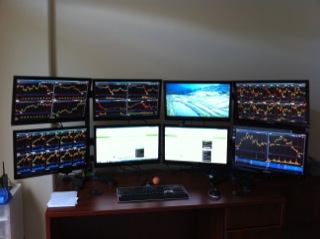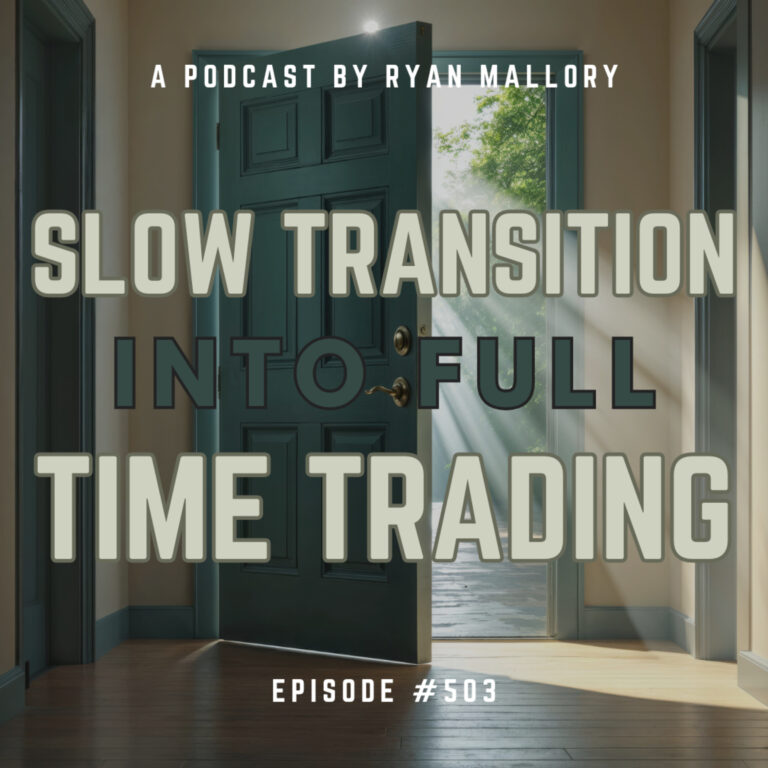I’ve recently built my own trading computer, which is a first for me because in the past I’ve always settled for an off-the-shelf desktop from a local electronics retailer. However, this time I decided to build my own desktop with custom components. Now, don’t think that the better the trading computer, the better trader you will be; instead, think of what type of  computer will best support your daily needs as a trader/investor in the financial markets. For example, a Forex trader may need something totally different than a Swing-Trader, and a Futures trader will need something totally different than a long-term investor.
computer will best support your daily needs as a trader/investor in the financial markets. For example, a Forex trader may need something totally different than a Swing-Trader, and a Futures trader will need something totally different than a long-term investor.
The computer I built is no doubt impressive. I probably could have spent more money for additional bragging rights, but at some point, ROI becomes a reality and common sense must be heeded. Ultimately, I had to draw a line on how much I was willing to spend; however, despite going with “good enough” in a few areas, this is the fastest computer I have ever sat behind. It is a machine that has made my trading experience much more seamless, especially when supporting an active blog, hedge fund, and other miscellaneous trading activities – activities that in the past took  quite a long time because I was constantly flipping through windows on my 2 desktop screens and laptop. With my new desktop, I now have eight screens, which has definitely enabled me to be much more efficient (even while sparing one display for the occasional movie when I hit a lull).
quite a long time because I was constantly flipping through windows on my 2 desktop screens and laptop. With my new desktop, I now have eight screens, which has definitely enabled me to be much more efficient (even while sparing one display for the occasional movie when I hit a lull).
Below I’ve provided the general specs on my machine, and I’ve added comments where applicable. I had a tech-savvy friend help me with my build, and I’m sure he’d be willing to offer some advice or provide a custom system build for a reasonable price. So, if you’re interested in an upgrade to your trading platform, just shoot me an email.
Monitors
Eight (8) 22″ Inch LCD Monitors
Comments: If you’re just looking at charts, spreadsheets, the Internet, and the occasional movie while you work, choose an economical TFT LCD display. Graphic artists and professional photographers may opt for more expensive LCD displays for better color reproduction.
Monitor Stands
Two (2) fully adjustable monitor supports (four displays per stand)
Comments: Plenty of different ones to choose from. Look for one that is robust and not likely to fall off the desk should someone inadvertently bump into it.
Case
One (1) full tower case
Comments: You’ll probably be running multiple video cards, multiple hard drives, and some miscellaneous peripherals, so make sure you choose a case with good air flow. Please don’t write me bragging about your $400 case – it is totally unnecessary. Find something more economical, preferably one that doesn’t light up like Disney World.
Hard Drives
Two (2) 1 TB electromechanical hard drives
Comments: Plan your hard drive quantity/capacity around how much information you are going to be storing, how you plan to organize your data, and how you want that data archived/backed-up. You may opt for more hard drives if you plan to use a RAID array.
Video Cards
Four (4) graphics cards with two (2) digital outputs per card
Comments: Pay careful attention to your motherboard capability when selecting the number of graphics cards you require.
Motherboard
One (1) ATX board with a LGA1366 socket
Comments: Before you buy, you REALLY need to make sure that your motherboard is capable of supporting your required components, that everything will fit on the board, and that the chosen hardware is compatible.
Processor
One (1) Intel Core i7-930 CPU
Memory (RAM)
12 GB DDR3-1333 PC3 10600/10666
DVD Player/Burner
One (1) DVD/CD Read/Write optical drive
Comments: Depending on what you need, this item will be relatively inexpensive. Unless you want a Blu-Ray player/writer, there is a myriad of optical drive choices for around $20.
Power Supply
One (1) 1000W power supply
There you have it – as for the Operating Plat form I am using, I suggest Windows 7 on 64-bit system. If you have any other questions, don’t be a stranger…Just Ask!

Welcome to Swing Trading the Stock Market Podcast!
I want you to become a better trader, and you know what? You absolutely can!
Commit these three rules to memory and to your trading:
#1: Manage the RISK ALWAYS!
#2: Keep the Losses Small
#3: Do #1 & #2 and the profits will take care of themselves.
That’s right, successful swing-trading is about managing the risk, and with Swing Trading the Stock Market podcast, I encourage you to email me (ryan@shareplanner.com) your questions, and there’s a good chance I’ll make a future podcast out of your stock market related question.
How should one go from their regular 9-5 job into full-time trading? As a swing trader, we don't have to necessarily be full-time, and instead we can combine our trading into a lifestyle that allows us to maximize our time and earning ability.
Be sure to check out my Swing-Trading offering through SharePlanner that goes hand-in-hand with my podcast, offering all of the research, charts and technical analysis on the stock market and individual stocks, not to mention my personal watch-lists, reviews and regular updates on the most popular stocks, including the all-important big tech stocks. Check it out now at: https://www.shareplanner.com/premium-plans
📈 START SWING-TRADING WITH ME! 📈
Click here to subscribe: https://shareplanner.com/tradingblock
— — — — — — — — —
💻 STOCK MARKET TRAINING COURSES 💻
Click here for all of my training courses: https://www.shareplanner.com/trading-academy
– The A-Z of the Self-Made Trader –https://www.shareplanner.com/the-a-z-of-the-self-made-trader
– The Winning Watch-List — https://www.shareplanner.com/winning-watchlist
– Patterns to Profits — https://www.shareplanner.com/patterns-to-profits
– Get 1-on-1 Coaching — https://www.shareplanner.com/coaching
— — — — — — — — —
❤️ SUBSCRIBE TO MY YOUTUBE CHANNEL 📺
Click here to subscribe: https://www.youtube.com/shareplanner?sub_confirmation=1
🎧 LISTEN TO MY PODCAST 🎵
Click here to listen to my podcast: https://open.spotify.com/show/5Nn7MhTB9HJSyQ0C6bMKXI
— — — — — — — — —
💰 FREE RESOURCES 💰
— — — — — — — — —
🛠 TOOLS OF THE TRADE 🛠
Software I use (TC2000): https://bit.ly/2HBdnBm
— — — — — — — — —
📱 FOLLOW SHAREPLANNER ON SOCIAL MEDIA 📱
*Disclaimer: Ryan Mallory is not a financial adviser and this podcast is for entertainment purposes only. Consult your financial adviser before making any decisions.




